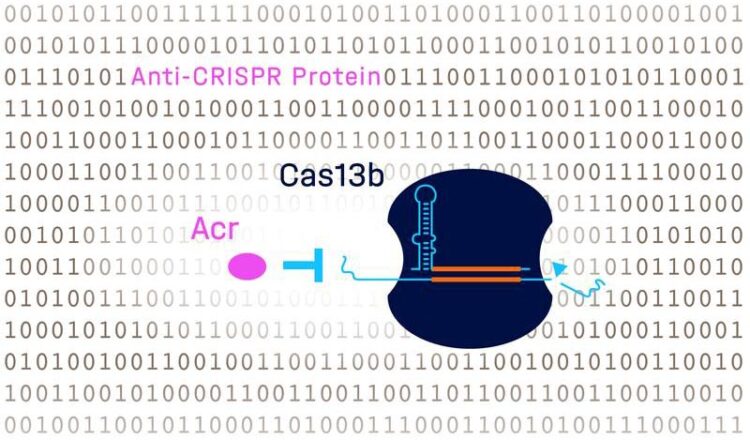A precision cut for the CRISPR-Cas genetic scissors

Using complex computational learning in combination with a high-throughput screen, a new anti-CRISPR protein was discovered that inhibits Cas13b.
Credit: HIRI/Chase Beisel
A new study indicates how deep learning can improve gene therapies and antiviral drugs.
The nuclease Cas13b associated with CRISPR defense systems—also known as genetic scissors—has the potential to be used in the future in hereditary diseases to silence adverse genes. In the fight against infections, it is also being researched as an antiviral agent, as Cas13b can target the genome of viruses and render them harmless. Despite these promising features, researchers are looking for nuclease inhibitors that can control or stop such activities. The aim is to increase the safety and efficacy of future therapies and to help prevent off-target effects. An international team led by the Helmholtz Institute in Würzburg in cooperation with the University of Freiburg has now applied deep learning for the first time to find natural nuclease inhibitors. The study, published today in the scientific journal “Molecular Cell”, identified the first such inhibitor that blocks the activity of Cas13b.
Bacteria often contain CRISPR-Cas defense systems that protect against viral invaders called phages. In response, phages have evolved proteins that can shut down CRISPR. These are called anti-CRISPR proteins, or Acrs. Researchers believe that there are numerous Acrs that have not yet been discovered. One of those is Chase Beisel, head of the RNA Synthetic Biology Department at the Helmholtz Institute for RNA-based Infection Research (HIRI) in Würzburg, a site of the Helmholtz Centre for Infection Research (HZI) in Braunschweig in cooperation with the Julius-Maximilians-Universität (JMU) Würzburg. “Acrs can be used to better control CRISPR technologies,” Beisel says, while acknowledging, “Identifying them means finding a needle in a haystack, since they look nothing like each other.” This, he says, has led scientific studies in the past to come up with new prediction tools. However, the success of these methods has been limited, says Beisel. He initiated the study published today in the journal “Molecular Cell”.
First example of using deep learning for Acr discovery
Consequently, a team of researchers from the HIRI in Würzburg, together with scientists from the Signalling Research Centres at the University of Freiburg and the Information and Computer Science Department at King Fahd University in Saudi Arabia, has pioneered the use of artificial intelligence to identify new Acrs.
“Using complex computational learning in combination with a high-throughput screen, we have succeeded in discovering a new anti-CRISPR protein that inhibits the clinically interesting nuclease Cas13b,” says Katharina Wandera. The PhD student in Chase Beisel’s lab is working on the characterization of Acrs and is a first author of the current paper.
“The millions of predictions made by our algorithm open up completely new avenues for research,” Rolf Backofen from the University of Freiburg is certain. His group developed the method, called DeepAcr, for the study.
The findings also suggest that DeepAcr can not only be used to discover new proteins that inhibit CRISPR-Cas systems lacking known Acrs. “The identified anti-CRISPR protein AcrVIB1 was not only unknown until now, it also seems to use a completely new mechanism of action,” summarizes Omer Alkhnbashi, an assistant professor at King Fahd University who shares the first authorship with Wandera.
Characterizing this mechanism of action is one of the next steps that will now follow the scientific work.
The study was supported by funds from the German Research Foundation (DFG) and the Safe Genes Program of the Defense Advanced Research Projects Agency (DARPA).
This press release is also available on our homepage: https://www.helmholtz-hzi.de/en/news-events/news/view/article/complete/praezisio…
Helmholtz Centre for Infection Research:
Scientists at the Helmholtz Centre for Infection Research (HZI) in Braunschweig and its other sites in Germany are engaged in the study of bacterial and viral infections and the body’s defence mechanisms. They have a profound expertise in natural compound research and its exploitation as a valuable source for novel anti-infectives. As member of the Helmholtz Association and the German Center for Infection Research (DZIF) the HZI performs translational research laying the ground for the development of new treatments and vaccines against infectious diseases. http://www.helmholtz-hzi.de/en
Helmholtz Institute for RNA-based Infection Research:
The Helmholtz Institute for RNA-based Infection Research (HIRI) was founded in May 2017. It is a joint institution of the Helmholtz Centre for Infection Research (HZI) in Braunschweig and the Julius-Maximilians-Universität Würzburg (JMU). Based on the University hospital campus, the HIRI is the first federal institute to focus on the role of ribonucleic acids (RNAs) in infection processes. Its mission is to combine basic research with the development of new RNA-centric therapeutic approaches to treat infections. http://www.helmholtz-hiri.de
Contact:
Dr. Britta Grigull
Presse & Public Relations
+49 (0)931-31-81801
britta.grigull@helmholtz-hiri.de
Originalpublikation:
Anti-CRISPR prediction using deep learning reveals an inhibitor of Cas13b nucleases. Wandera KG, Alkhnbashi OS, Bassett HVI, Mitrofanov A, Hauns S, Migur A, Backofen R, Beisel CL (2022). Molecular Cell. DOI: 10.1016/j.molcel.2022.05.003
Media Contact
All latest news from the category: Life Sciences and Chemistry
Articles and reports from the Life Sciences and chemistry area deal with applied and basic research into modern biology, chemistry and human medicine.
Valuable information can be found on a range of life sciences fields including bacteriology, biochemistry, bionics, bioinformatics, biophysics, biotechnology, genetics, geobotany, human biology, marine biology, microbiology, molecular biology, cellular biology, zoology, bioinorganic chemistry, microchemistry and environmental chemistry.
Newest articles

High-energy-density aqueous battery based on halogen multi-electron transfer
Traditional non-aqueous lithium-ion batteries have a high energy density, but their safety is compromised due to the flammable organic electrolytes they utilize. Aqueous batteries use water as the solvent for…

First-ever combined heart pump and pig kidney transplant
…gives new hope to patient with terminal illness. Surgeons at NYU Langone Health performed the first-ever combined mechanical heart pump and gene-edited pig kidney transplant surgery in a 54-year-old woman…

Biophysics: Testing how well biomarkers work
LMU researchers have developed a method to determine how reliably target proteins can be labeled using super-resolution fluorescence microscopy. Modern microscopy techniques make it possible to examine the inner workings…





















